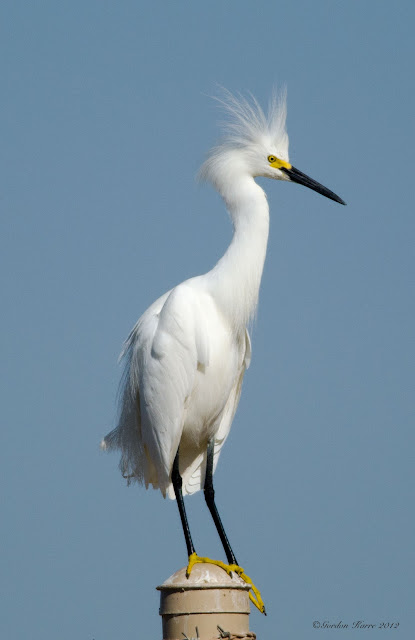Today I wanted to take advantage of the cool morning air and traveled to Tres Rios Wetlands along the Salt River in the west valley. This is another birder's paradise and much of it is off limits and inaccessible without permission for birding on the west side of 91st Ave. On the east side of 91st Ave is the Hayfield Site that is open to all. Although I did not get any photos, I did actually see my first Least Bitterns and was very excited. I knew they existed there as I have heard them in the past, but they are very elusive and sometimes very hard to spot. The excitement at the Hayfield site was a Western Wood Pewee that put on quite a show, flying out to capture an insect and then flying back to devour its morsel. This one capture what I believe is a Mexican Amberwing Dragonfly (correct me if I am wrong), and gave me a lot of shots of it with the insect in its beak. What was interesting was that just before it swallowed the insect, it flipped it in the air to position it so it went down head first, sort of like a heron or egret when swallowing a fish. Here is shot just before the insect disappeared down the hatch.
Western Wood Pewee
On the west side I was treated to a wide variety of birds, some common and some not so common and some just being difficult to photograph! First up is a Song Sparrow that wanted to play 'hide-n-seek' with me in the bushes.
Song Sparrow
Next we have a Red-winged Blackbird, which is very common and quite gregarious. Most of them must have already raised one clutch as the reeds and bushes were full of juveniles. The photo below is an adult male that was being quite vocal.
Red-winged Blackbird
The next couple of photos are of birds that are difficult to photograph. The Common Yellowthroat likes to hide in reeds and brush along streams, but this one popped up long enough to get this photo. The Blue Grosbeak is a stunningly beautiful bird, but they seem to be a bit skittish and, at least for me, difficult to approach and get a good photo of one.
Common Yellowthroat
Blue Grosbeak
Killdeer are very common and quite vocal with their calls that are very distinct. Even though they are usually found near water, it is just a bit uncommon to see them actually standing in water like this one.
Killdeer
And finally, a Snowy Egret was putting on a courtship display to an eligible female. Those plumes are stunning when on display.
Snowy Egret








Nice work Gordon!! I've never gotten Western Wood Pewee or Blue Grosbeak at Tres Rios, looks like the site was good to you!
ReplyDeleteI'll have one more weekend of birding before leaving to Pennsylvania for a couple weeks, and I definitely want to fit another Tres Rios trip in before departing, especially now that there are Blue Grosbeaks around!!
Wow, can't believe you got the shot of the Western Wood Pewee eating lunch - incredible!
ReplyDeleteThat photo is one of the benefits of one of the new DSLR cameras. You can focus in and then hold down the button for multiple photos very fast in a row. My camera will take 4.5 photos per second in the optimum conditions. So many of the things that take place in nature happen so fast that most of us rarely see the details of what happens. This is the result and it is always quite a learning tool. I have captured a bit of natural history that no one else has captured, even though it is so miniscule in comparison to what happens every day in our amazing world. Thanks for the comments!
Delete